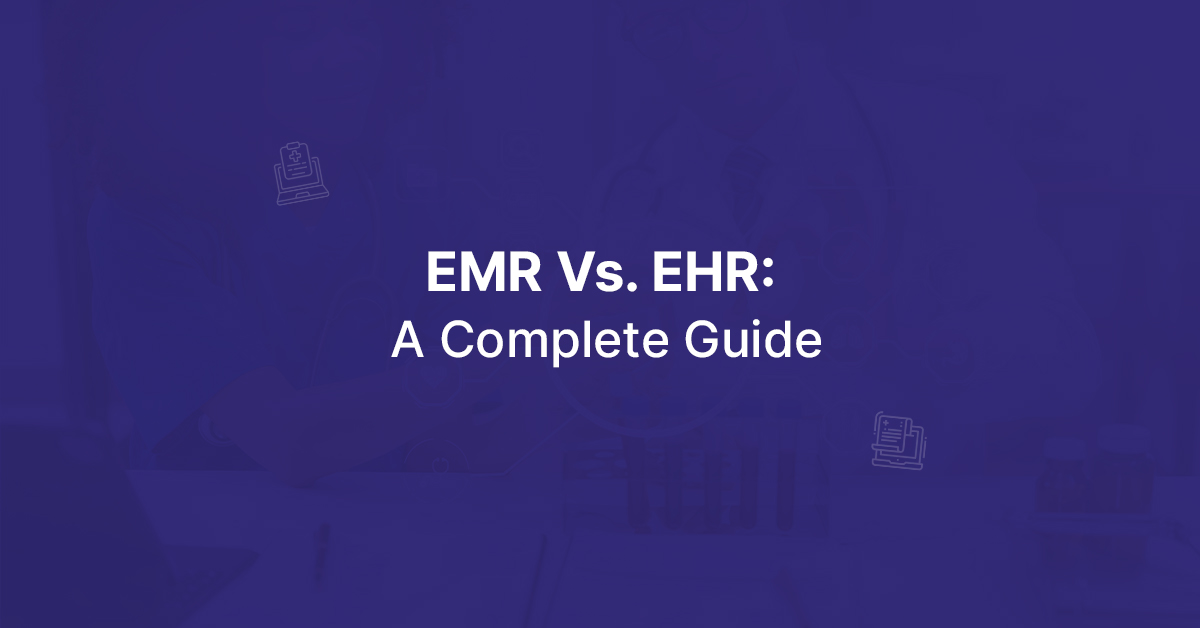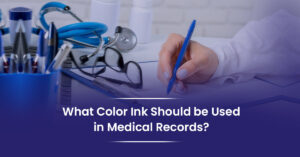The era of dog-eared manila folders brimming with medical forms has given way to the digital domain. Healthcare now charts a course for the electronic storage and transmission of patient information.
Two principal electronic systems have dropped anchor: the Electronic Medical Record (EMR) and Electronic Health Record (EHR).
At first glance, the two appear lashed together under a similar banner. However, the distinction between the EMR and EHR is as clear as an azure sky meeting a cobalt sea.
But what exactly are EMR and EHR, their differences, and how do they impact healthcare delivery? Let’s read.
What is an Electronic Medical Record (EMR)?
Think of the EMR as the doctor’s own personal medical story of their patient – their symptoms, diagnoses, medications, tests, procedures. This digital chart, versus the old paper kind, lets the physician and office staff call up a patient’s complete history at the click of a button. All the details are there in one place – chronic conditions, past treatments, current meds, vaccination records, and more.
This centralized electronic system safely keeps the patient’s information private while allowing the care team to access and update it in real time.
It is to be noted that the EMR focuses squarely on that patient’s care within that practice, creating an intimate record of their treatment journey under that provider’s care. It is the doctor’s own medical narrative.
An EMR typically includes a wide range of patient information, such as:
- Patient Demographics: Basic information like the patient’s name, date of birth, address, and contact details.
- Symptoms and Diagnoses: Detailed documentation of a patient’s symptoms, diagnoses made by physicians, and implemented treatment plans.
- Medication Management: A record of current medications, dosage instructions, and potential allergies.
- Analytics and Reporting Module: Analytical reports to assist providers track KPIs, identify areas for improvement, and make informed decisions.
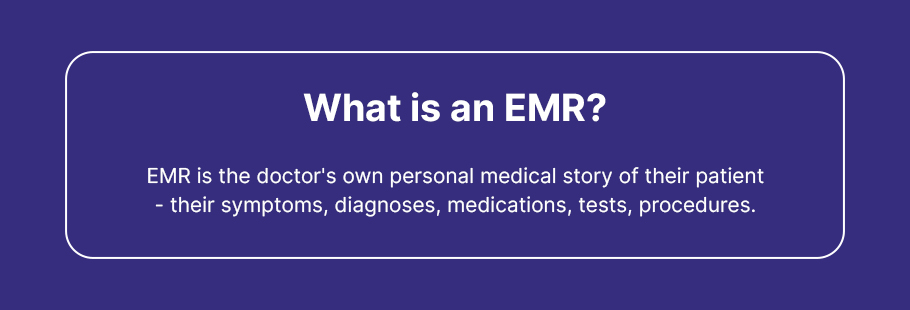
Detailed Breakdown of the Components of an EMR System
Electronic Medical Records (EMRs) have transformed the healthcare industry by offering a digital platform to manage patient information. Understanding the core components of an EMR is important for making informed decisions when choosing the right system for your practice.
Here’s a breakdown of the essential functionalities that define a robust EMR:
1. Analytics, Dashboards & Reports
Dashboards: Provide real-time access to crucial patient health data, presented in an easy-to-understand format. This empowers healthcare providers to make quick and informed decisions during urgent situations, routine check-ups, or managing chronic conditions like diabetes.
Customizable Reports & Dashboards: Allow creation of personalized views tailored to specific needs. You can design reports to quickly review a patient’s medical history, compare it to their current status, or track trends over time.
Advanced Reporting: Facilitates the generation of detailed reports for various purposes. These reports can be used for patient case tracking, analyzing referral conversion rates, assessing staff performance, monitoring inventory, and gaining insights into various aspects of your practice.
Data-Driven Decisions: By offering a clear view of your data, EMRs empower data-driven decision making. This can lead to improved communication within your practice, a more conducive work environment, and ultimately, enhanced care delivery methods.
2. Patient Charts
Centralized Repository: EMRs eliminate the need for paper charts, offering a secure and digital solution for storing all essential patient information. This includes registration details, consultation notes, treatment records, surgical history, medication documentation, and more – all accessible within a single platform.
Additional Information: Clinical charts can encompass other elements such as:
- Chief Complaint (CC): A concise term capturing the primary reason for a patient’s visit.
- History of Present Illness (HPI): Provides a detailed narrative of the illness progression, from initial symptoms to the current state of health.
- Review of Systems (ROS): Utilizes a standardized set of questions to identify potential issues and diseases across different organ systems.
Enhanced Features: EMR systems may offer additional functionalities to streamline chart management, such as:
- Auto Save: Ensures information is automatically saved, eliminating the risk of data loss.
- Day Notes: Allows for quick documentation of daily patient encounters.
- Encounter Summaries: Provides a comprehensive overview of each patient visit.
- Flowsheets: Offer a visual representation of a patient’s health status over time, allowing for easy tracking of vital signs or other key metrics.
- Patient Vitals: Enables efficient recording and storage of vital signs like temperature, blood pressure, and heart rate.
- Preventive Screening Tools: Provides checklists and questionnaires to facilitate preventive care measures.
3. Clinical Workflows
Digital Patient Journey: EMRs enable the management of the entire patient care journey using a digital system. This includes registration, check-in, check-out, and post-treatment details.
Improved Team Communication: Streamlined workflows facilitate better communication and collaboration among healthcare teams, leading to improved care coordination and overall patient outcomes.
Data-Driven Optimization: By providing insights into staff efficiency and patient health trends, EMRs enable data-driven strategies to optimize clinical operations. These insights can be used to identify areas for improvement and implement innovative approaches to enhance healthcare delivery.
4. Collaboration Tools
Secure Messaging: EMRs often integrate secure messaging platforms that allow patients and doctors to communicate easily. This can be used for various purposes, including addressing questions, scheduling appointments, requesting prescription refills, or sharing health information.
Virtual Interactions: Some EMRs offer features like screen sharing, video conferencing, and the ability to send photos and documents. This empowers doctors to provide more comprehensive virtual consultations, improving patient engagement and satisfaction.
5. Electronic Prescriptions (E-Prescribing)
Improved Medication Management: E-prescribing allows doctors to review a patient’s medication history before prescribing new medications. This minimizes the risk of errors, drug interactions, and adverse reactions.
Enhanced Features: E-prescribing functionalities may include:
- Benefit Verification & Formulary Checks: Ensures medications are covered by a patient’s insurance and avoids prescribing medications that may interact with existing medications.
- Clinical Decision Support: Provides real-time guidance to doctors based on best practices and patient-specific factors.
- Dose Calculators: Assists healthcare providers in calculating the correct medication dosage based on the patient’s age, weight, and other factors.
Electronic Prescribing of Controlled Substances (EPCS): Allows for the secure electronic prescribing of controlled substances.
What is an Electronic Health Record (EHR)?
An electronic health record, or EHR, aims to paint the full picture of a patient’s medical history. It is a digital archive that gathers up documents from all the doctors, specialists, labs, imaging centers and pharmacies a man or woman has visited over the years.
Primary care doctors, specialists, surgeons and other providers all contribute chapters to this ongoing memoir. With a few clicks, any clinician can log into the EHR system and read through the patient’s complete healthcare journey. This saves the hassle of tracking down records from various sources and provides the full context needed to deliver coordinated care.
In short, the EHR offers a bird’s eye view of the patient’s healthcare journey, with detailed records spanning providers, dates and decades. It is the master portfolio containing their complete medical biography.
Here’s the list of key components of an EHR:
- Patient Demographics: Basic patient information like name, date of birth, address, and contact details.
- Medical History: A detailed record of a patient’s past illnesses, surgeries, allergies, immunizations, and medications, incorporating information from different healthcare providers.
- Symptoms and Diagnoses: Documentation of presenting symptoms, diagnoses made by various physicians throughout the patient’s healthcare journey, and treatment plans implemented across different care settings.
- Lab Results: Electronic copies of laboratory test results, X-rays, imaging scans, and other diagnostic reports from various facilities.
- Progress Notes: Notes and observations documented by physicians and other healthcare professionals during patient encounters.
- Insurance Information: Detailed representation of current insurance coverage helping providers verify eligibility and proceed accordingly.
- Medication Management: A comprehensive record of current medications, dosage instructions, and potential allergies, incorporating information from different providers.
- Preventive Care Records: Documentation of vaccinations received, screenings performed, and upcoming preventive care recommendations.
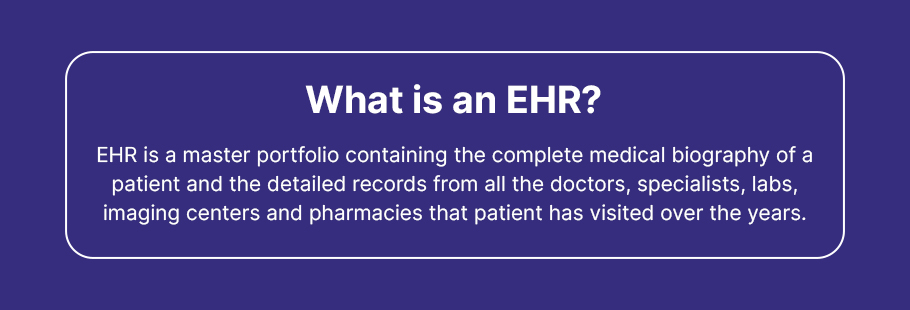
Detailed Breakdown of the Components of an EHR System
An EHR system consists of various functional components working together to deliver a seamless experience for both patients and healthcare providers. Here’s a breakdown of some key components:
1. Patient Management
- Facilitates capture, storage, and retrieval of up-to-date patient information, including demographics, insurance details, past medical history, emergency contacts, and a unique medical record number.
2. Clinical Component
- Equips care teams with decision support tools to deliver quality care.
- Allows for electronic documentation of patient interactions, including history & physicals, operative notes, nursing care plans, and medication orders.
3. Secure Messaging and Alerts
- Integrates secure messaging and alerting solutions to streamline communication flow between healthcare providers.
- Enables real-time alerts for critical situations, facilitating prompt intervention and improved patient outcomes.
4. Financial Dashboards
- Integrates RCM functionalities to enhance revenue collection and financial performance.
- Provides financial insights to healthcare providers through easy-to-use dashboards.
- Offers reports on clinical and financial metrics, aiding informed decision-making about practice operations.
5. Revenue Cycle Management (RCM)
- Offers real-time data for informed financial decisions and improved patient care sustainability.
- Integrates RCM functionalities to enhance revenue collection and financial performance.
6. Clinical Data Repository
- The core component, storing all patient clinical data (demographics, medical history, medications, allergies, lab results, imaging reports).
- Utilizes standardized data formats for easy exchange between different EHR systems and healthcare applications.
- Crucial for providing a single source of truth for clinicians and generating reports to track patient trends and improve care delivery.
7. Clinical Decision Support System (CDSS)
- A computer-based system that provides clinicians with information and tools for better decision-making.
- Integrates with EHRs, utilizing patient data, clinical guidelines, and research evidence to generate recommendations.
- Offers functionalities like alerts, order sets, clinical scoring tools, and evidence summaries.
- Aims to improve quality of care by reducing errors, promoting adherence to guidelines, and offering evidence-based support.
8. Order Entry System (OES)
- Allows electronic ordering of tests, medications, and other patient services.
- Integrates with EHRs, enabling selection from pre-built options or entering custom orders.
- Electronically transmits orders to the appropriate healthcare provider or department.
- Tracks order status for improved workflow efficiency.
9. Patient Portal
- A secure online platform giving patients access to their medical records and communication channels with providers.
- Enables patients to view medical history, lab results, imaging reports, and other relevant information.
- Facilitates secure messaging with providers for inquiries, appointment requests, prescription refills, and bill payments.
- Empowers patients to be more informed participants in their healthcare journey.
10. Reporting System
- Generates reports on patient data for various purposes.
- Offers population health reports (disease prevalence, healthcare service utilization), quality improvement reports (patient outcomes, guideline adherence), regulatory compliance.
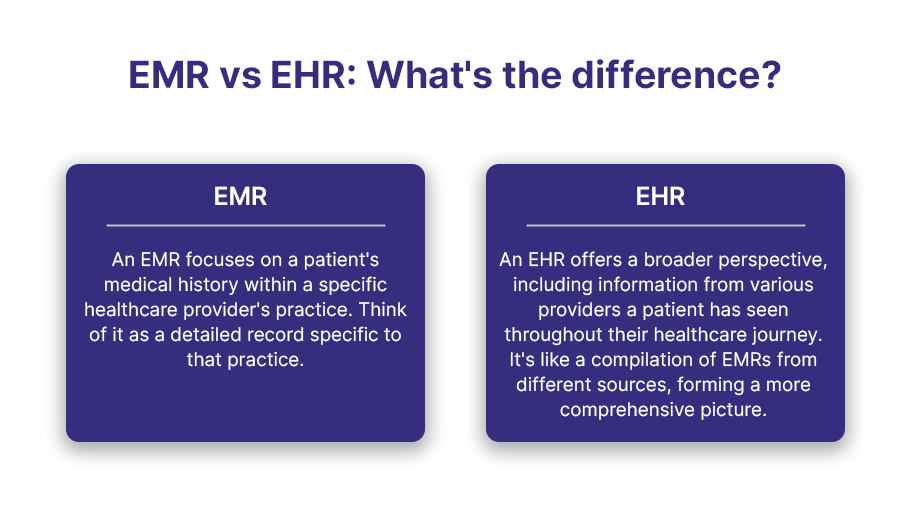
EMR Vs. EHR: The main differences explained
The difference between an Electronic Health Record and an Electronic Medical Record comes down to scope.
The EMR represents a siloed set of patient information from a single medical practice. This detailed record reflects care administered by that provider alone – think of the files kept by a primary care physician. This localized record reflects the work of an individual provider, such as a family doctor. For example, an EMR may include details of annual checkups, diagnosed conditions, and prescriptions.
The EHR, on the other hand, paints with a broader brush — incorporating records from multiple providers to form a more comprehensive picture of a patient’s medical history. For instance, the EHR may include specialist referrals and hospital visits in addition to primary care.
So while the EMR offers an in-depth view of care from a single practice, the EHR stitches together a quilt of medical encounters from across providers.
Since EMRs and EHRs are interchangeably used however, when selecting either software, it’s crucial to consider your clinic’s specific requirements to ensure optimal functionality and compatibility.
Let’s dive into the key differences between EMRs and EHRs:
1). EMR vs EHR – Scope of Information:
EMR (Electronic Medical Record): An EMR serves as a digital version of a traditional medical chart, focusing on a patient’s medical history within a specific healthcare provider’s practice (doctor’s office, hospital department, etc). It primarily includes information collected during a patient’s encounters with that specific provider.
EHR (Electronic Health Record): An EHR offers a more comprehensive view. It acts as a centralized repository, storing and integrating a patient’s medical information from various healthcare providers throughout their lifetime. Think of it as a complete picture, incorporating data from doctors, specialists, hospitals, and other healthcare settings a patient has visited.
2). EMR vs EHR – Accessibility:
EMR (Electronic Medical Record): EMRs are typically accessible by authorized personnel within the specific healthcare provider’s practice where the information was generated. Sharing information with other providers often requires manual intervention or specific data exchange protocols.
EHR (Electronic Health Record): EHRs are designed for broader accessibility, ideally allowing authorized healthcare providers across different healthcare systems to access a patient’s complete medical history with their consent. This fosters better care coordination and collaboration between specialists involved in a patient’s treatment.
3). EMR vs EHR – Focus:
EMR (Electronic Medical Record): EMRs primarily focus on documenting a patient’s medical history within a single practice. This includes details like symptoms, diagnoses, treatments, medications, and lab results collected during their visits to that specific provider.
EHR (Electronic Health Record): EHRs take a more holistic approach, aiming to provide a complete picture of a patient’s health. They not only incorporate information from various providers but may also include preventive care records, immunization history, and social determinants of health that can influence overall well-being.
| Feature | EMR (Electronic Medical Record) | EHR (Electronic Health Record) |
| Scope of Information | Focuses on a patient’s medical history within a specific healthcare provider’s practice | Offers a comprehensive view, integrating information from various providers throughout a patient’s healthcare journey |
| Accessibility | Primarily accessible by authorized personnel within the specific practice | Designed for broader accessibility by authorized providers across different healthcare systems (with patient consent) |
| Focus | Documents medical history within a single practice (symptoms, diagnoses, treatments, medications, lab results) | Provides a holistic view, incorporating information from various providers and considering preventive care, immunizations, etc. |
EHR and EMR in Healthcare: Why EHR is better?
When it comes to managing patient records in the healthcare industry, electronic records systems have become increasingly popular. While both EMR and EHR offer digital solutions, there are distinct advantages to using EHR. One of the main benefits is the ability to share information between different healthcare providers, making it easier to coordinate care and avoid errors.
Here are the top reasons that give EHR a superlative edge over the EMR system:
Enhanced Care Coordination
Though EMRs assist independent practices in monitoring patients, EHRs allow for advanced coordination between doctors. Having access to complete records, providers can team up to plan first-rate care.
EHRs present clear advantages in terms of comprehensive patient histories and enhanced care coordination between providers. Armed with a patient’s complete records across multiple sites of care, physicians can better collaborate on treatment plans, reviewing the same information to deliver superior coordinated care.
However, EMRs retain merits for smaller, independent practices. Their lower price points and simpler implementation make EMR adoption realistic for clinics lacking resources. Within their own patient population, EMRs help identify trends and inform treatment decisions.
Improved Communication
EHRs synthesize big data across institutions to optimize treatment, whereas EMRs digitize charts economically for private practices.
Electronic health records offer patients and doctors alike a glimpse into the whole picture of one’s wellbeing. Through EHRs, patients can see their test results, message their doctors, and make choices about their care with eyes wide open. For physicians, EHRs unlock a wealth of knowledge to provide the best treatment. They can see what other doctors have prescribed, results of past procedures, and patterns that point to better solutions. EHRs are best suited for large hospitals and integrated health systems, where cooperation and coordination are most valued.
Electronic medical records, on the other hand, are useful for small practices where simplicity and low cost are priorities. EMRs do a fine job of digitizing patient charts and prescriptions, freeing up space in cramped medical offices.
Reduced Risk of Errors
EMRs may remedy the inefficiencies of paper files for small practices, but EHRs remedy the perils of fragmented care. Once a patient’s medical information is gathered from every portal they’ve passed through, doctors using EHR gain an omniscient perspective that allows them to make the right choices and avoid potentially fatal mistakes.
For a private physician’s office, an EMR offers a more organized system than paper files. Doctors can easily pull up digital charts, lab results and prescription histories for more efficient visits. This consolidated access benefits small clinics with limited staff and infrastructure.
However, larger hospitals and health networks gain more from comprehensive EHRs. With patient data integrated from various offices, labs and pharmacies, EHRs give different providers a shared understanding of each case. This reduces misdiagnoses and mistakes caused by fragmented paper trails or poor penmanship. EHRs also enable doctors to spot health patterns not visible within just one practice’s EMR dataset.
Personalized Patient Care
EHRs give doctors a complete view to shape care around patients as individuals. EMRs work fine for standalone clinics, yet they don’t have the whole story for personalized medicine.
While both EMRs and EHRs digitize patient information for providers, EHR systems offer more robust data and care coordination benefits, healthcare experts say.
EHRs give authorized providers a comprehensive view of a patient’s medical history across multiple care sites to enhance treatment personalization. Access to a patient’s complete health profile allows physicians to craft tailored care plans addressing their unique needs, risks and conditions.
An EMR, containing data siloed within one facility, provides less insight for personalized medicine. However, for independent clinics, EMR systems can efficiently digitize their patient records and medical workflows.
For larger integrated delivery networks and accountable care organizations, EHR systems better suit their needs for data fluidity across care settings to deliver high-value customized care.
Informed Decision-Making
Though EMR helps small clinics work better, EHR’s broad access to a patient’s history gives doctors a fuller perspective to make wiser choices about care.
EHR’s broad access to patient history grants providers a valuable, more holistic perspective. With medical, lab, pharmacy and other records integrated from multiple sources, physicians gain a fuller understanding of the patient’s health profile. This comprehensive view allows for more informed decision-making regarding diagnoses and treatment plans.
Yet EMR still has merits, especially for small or solo practices where clinical data sharing across organizations is less critical. For these providers, digitizing and organizing patient records can improve workflow efficiency, billing processes and compliance with regulations.
Improved Quality of Care
EHRs assemble a wide-ranging outlook by merging records across doctors. This facilitates preventive care through screening prompts and medication monitoring regardless of which physician a patient visits. EMRs focus more narrowly on the daily operations of private practices.
EHRs create a broader view by integrating records across providers. This aids preventative care through screening reminders and medication monitoring regardless of where a patient seeks treatment. EMRs have a narrower focus on office workflows for individual practices.
Small clinics may find EMRs more affordable and customized to their needs. But when it comes to big picture care coordination, EHRs have the upper hand.
Future Trends of Electronic Records in the Medical Domain
Electronic Medical Records (EMRs) and Electronic Health Records (EHRs) have revolutionized healthcare by enabling secure, digital management of patient information. But the future holds even more exciting possibilities, with a focus on improved information gain, interoperability, and leveraging the power of big data.
Here are the top future trends of EMR/EHR:
Interoperability Policies and Incentives:
- Ongoing regulations will ensure EHR systems seamlessly exchange data between different healthcare providers. This fosters a more holistic view of a patient’s health and eliminates duplicate testing.
- Government initiatives like Meaningful Use will financially incentivize healthcare organizations to adopt interoperable EMR/EHR systems, further accelerating data exchange.
Cloud-Based Security with Encrypted Access:
- Cloud computing offers scalability, remote accessibility, and automatic backups, making it the preferred platform for future EMR/EHR systems.
- Emphasis will be placed on robust security measures like encryption to safeguard sensitive patient data from cyberattacks, phishing attempts, and unauthorized access.
Standardization and Open APIs:
- Standardized data formats will ensure seamless information exchange between different EHR systems, regardless of vendor.
- Open application programming interfaces (APIs) will allow third-party developers to create innovative healthcare applications that integrate seamlessly with existing EMR/EHR systems, empowering patients with a wider range of tools to manage their health.
Robotic Process Automation (RPA):
- RPA automates repetitive tasks like data entry, reducing human error and improving data accuracy within EMR/EHR systems. This frees up healthcare professionals to focus on patient care.
- Integration of RPA with existing EMR/EHR systems will be streamlined, offering healthcare providers a practical solution to improve system efficiency and reduce manual workload.
Telehealth Integration:
- EMR/EHR systems will integrate seamlessly with telehealth platforms, enabling secure and efficient remote patient care.
- This integration will allow for real-time data exchange during virtual consultations, improving care delivery and patient engagement.
The Rise of AI, Voice Recognition, and NLP:
- Artificial intelligence (AI) will play a crucial role in analyzing vast amounts of patient data stored in EMR/EHR systems.
- AI-powered voice recognition will enhance data entry speed and accuracy, allowing doctors to focus on the patient during consultations.
- Natural Language Processing (NLP) will enable EMR/EHR systems to understand and interpret clinical notes, improving data searchability and facilitating better clinical decision-making.
Blockchain Technology for Enhanced Security:
- Blockchain technology offers a secure and tamper-proof way to store and manage patient data in EMR/EHR systems.
- This technology eliminates the need for expensive integrations between different healthcare providers, allowing authorized personnel to access patient records securely from any location.
Big Data, 5G, and 6G for Faster Analytics:
- The explosion of healthcare data from wearables, sensors, and EMR/EHR systems necessitates big data analytics for meaningful insights.
- Advanced analytics can identify trends, predict potential health risks, and personalize treatment plans for patients.
- The advent of 5G and the development of 6G technologies will provide the high-speed data transmission needed for real-time processing and analysis of large datasets.
Wearable Devices and Data Integration:
- Wearable devices will play a bigger role in healthcare, offering a continuous stream of patient health data. These devices enable you to actively track patient health metrics from their every-day activities to health condition, and medication routine, etc.
- EMR/EHR systems will integrate data from wearables, providing a more comprehensive view of a patient’s health and enabling proactive care interventions.
Real-Time Data and Analytics for Clinical Decision Support:
- EMR/EHR systems will leverage real-time data analytics to provide clinical decision support (CDS) to healthcare professionals at the point of care.
- This real-time data will empower doctors to make more informed decisions, potentially leading to improved patient outcomes.
By embracing these future trends, EMR/EHR systems will evolve into powerful tools for data-driven healthcare. This will ultimately lead to a more efficient, cost-effective, and patient-centered healthcare experience.
Conclusion
EHR and EMR are often interchangeably used however, there’s a key difference. An EMR focuses on a patient’s medical history within a specific healthcare provider’s practice. Think of it as a detailed record specific to that practice.
An EHR, on the other hand, offers a broader perspective, including information from various providers a patient has seen throughout their healthcare journey. It’s like a compilation of EMRs from different sources, forming a more comprehensive picture.
